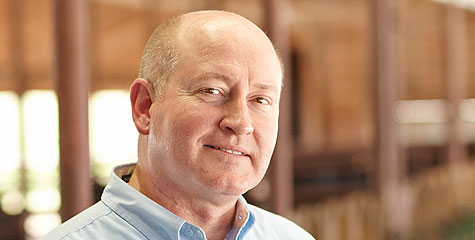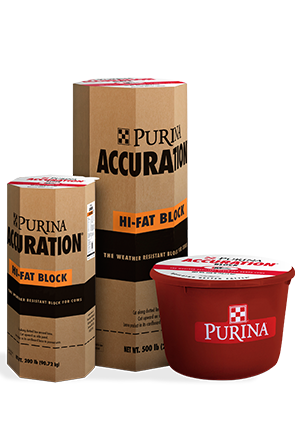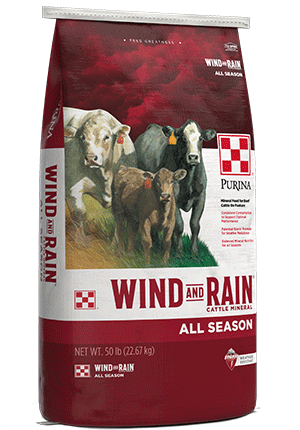
The Domino Effect: How Cattle Nutrition and Breeding Are Linked
Management : Cow & Calf
Management : Replacement
Nutrition : Minerals
Nutrition : Supplements
Nutrition : Forage
If you’ve ever set up dominoes, you know that when one domino falls, the rest follow suit. Similarly, your cattle nutrition program can set off a chain reaction affecting your breeding program.
A cow with poor nutrition might take longer to breed back, or she might not conceive at all. The longer a cow stays open, the more money you’re losing on her. If a cow on lower-quality nutrition does rebreed, she could have trouble calving resulting in a less thrifty calf.
Another domino in the chain is colostrum production. An undernourished cow might not have the nutrients needed to produce high-quality colostrum. Low-quality colostrum doesn’t provide newborn calves with the same vital benefits as high-quality colostrum, benefits that last well beyond birth.1
High-quality cattle nutrition supports a productive breeding season and the domino effect only snowballs from there.Use Body Condition Score as the Barometer
Body condition score is a good barometer of your cattle nutrition program and what your reproductive success might be. Cows managed for body condition score 6 at calving rebreed with better conception rates than cows calving in a lower body condition score.2 See Graph 1.
Monitor cow body condition scores regularly, and during critical times such as during calving season and , to help determine your herd’s nutritional needs in real time.
And be aware that playing catch-up can be costly. Cows at a body condition score 3.5 at calving need to gain upwards of three pounds per head per day to be at body condition score 5.5 before breeding, which is difficult to do in most conditions.
For example, if a cow calves in March this year, then she calves in April next year and she calves in June the following year. She’s not calving every 365 days and will eventually leave the herd because at some point she'll begin cycling after the bull is pulled out.
A tighter breeding season also prepares cows for a shorter calving season, which has additional economic benefit. A 60-day calving window can produce a more uniform calf crop, heavier calves and, ultimately, more pounds to sell.
A 60-day might seem like a lofty goal, but it can be achieved with the proper balance of management, genetics, nutrition and health.
The reality is, forages aren’t consistent throughout the year. Quality declines when forages are dormant. also provide lower quantity nutrition.
Forage type, quality and seasonality all contribute to volatile nutrition. Steady and throughout the year essentially serves as an insurance policy to protect your cows from nutrition gaps.
Does your cattle nutrition program stack up? Find out with a Proof Pays feeding trial.
1 University of Nebraska-Lincoln. “Care of the Newborn Calf: Colostrum Management Webinar”, accessed from https://beef.unl.edu/newborn-calf-colostrum-management.
A cow with poor nutrition might take longer to breed back, or she might not conceive at all. The longer a cow stays open, the more money you’re losing on her. If a cow on lower-quality nutrition does rebreed, she could have trouble calving resulting in a less thrifty calf.
Another domino in the chain is colostrum production. An undernourished cow might not have the nutrients needed to produce high-quality colostrum. Low-quality colostrum doesn’t provide newborn calves with the same vital benefits as high-quality colostrum, benefits that last well beyond birth.1
High-quality cattle nutrition supports a productive breeding season and the domino effect only snowballs from there.
Use Body Condition Score as the Barometer
Body condition score is a good barometer of your cattle nutrition program and what your reproductive success might be. Cows managed for body condition score 6 at calving rebreed with better conception rates than cows calving in a lower body condition score.2 See Graph 1.
And be aware that playing catch-up can be costly. Cows at a body condition score 3.5 at calving need to gain upwards of three pounds per head per day to be at body condition score 5.5 before breeding, which is difficult to do in most conditions.
Tighten up the Windows
Cows must be bred within 85 days after calving to have one calf per year. And, cows that don’t produce a calf every year cost you money.For example, if a cow calves in March this year, then she calves in April next year and she calves in June the following year. She’s not calving every 365 days and will eventually leave the herd because at some point she'll begin cycling after the bull is pulled out.
A tighter breeding season also prepares cows for a shorter calving season, which has additional economic benefit. A 60-day calving window can produce a more uniform calf crop, heavier calves and, ultimately, more pounds to sell.
A 60-day might seem like a lofty goal, but it can be achieved with the proper balance of management, genetics, nutrition and health.
Set off the Right Chain Reaction
The “right” cattle nutrition looks different for every operation, but year-round, high-quality nutrition can optimize conception rates, tighten the calving season and get more calves on the ground quicker.The reality is, forages aren’t consistent throughout the year. Quality declines when forages are dormant. also provide lower quantity nutrition.
Forage type, quality and seasonality all contribute to volatile nutrition. Steady and throughout the year essentially serves as an insurance policy to protect your cows from nutrition gaps.
Does your cattle nutrition program stack up? Find out with a Proof Pays feeding trial.
1 University of Nebraska-Lincoln. “Care of the Newborn Calf: Colostrum Management Webinar”, accessed from https://beef.unl.edu/newborn-calf-colostrum-management.
2 Rasby, R. J., Stalker, A., and Funston, R.N. “Body condition scoring beef cows: A tool for managing the nutrition program for beef herds.” UNL Beef Extension EC 281, accessed Nov. 2, 2017, http://extensionpublications.unl.edu/assets/pdf/ec281.pdf





